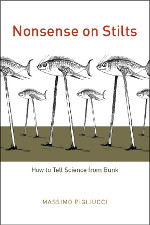On the Nature of Science and Psuedoscience

Climate change—and the debate about its causes or validity—is a subject of perpetual interest. Recently, we told you about the chasm between meteorologists—who predict short-term weather patterns and remain skeptical about long-term change—and climatologists—who, as the New York Times reported, “almost universally endorse the view that the earth is warming and that humans have contributed to climate change.” (Stephen Colbert also recently covered in conflict with an amusing “Science Catfight” between Joe Bastardi, a weather forcaster, and Brenda Ekwurzel, of the Union of Concerned Scientists.)
Now the UK’s Independent has offered an overview of books that “separate global warming fact from fiction.” And Massimo Pigliucci’s Nonsense on Stilts: How to Tell Science from Bunk get singled out as “entertaining and valuable guide to sorting the scientific grain from the chaff of pseudoscience.”
He makes a distinction that clarifies some of our current problems. There are two kinds of bone fide science: one is law-based and experimental, cut-and-dried as a crystal chalice or a perfect intertwined double helix of DNA. Then there are historical sciences such as evolution or climate research that employ “the methods of a crime detective.” .… As Pigliucci points out, what happened happened, and can be deduced by the trail it left; what might happen in the future involves contingency, freak occurrences that can tip the path of events onto a different course—”for want of a nail…”. We can reconstruct the meteorite event of 65 million years ago but cannot predict the next such strike. We are left with a range of probabilities.
In the new book, Pigliucci explores the nature of science, the borderlands of fringe science, and—borrowing a famous phrase from philosopher Jeremy Bentham—the nonsense on stilts. Presenting case studies on a number of controversial topics, Pigliucci cuts through the ambiguity surrounding science to look more closely at how science is conducted, how it is disseminated, how it is interpreted, and what it means to our society. Although the Independent praised Pigliucci, not every one agrees. In The Chronicle Review, Carlin Romano offers a different—and less admirative—perspective on the book. But, given the contentious nature of the book, we expect a robust debate.